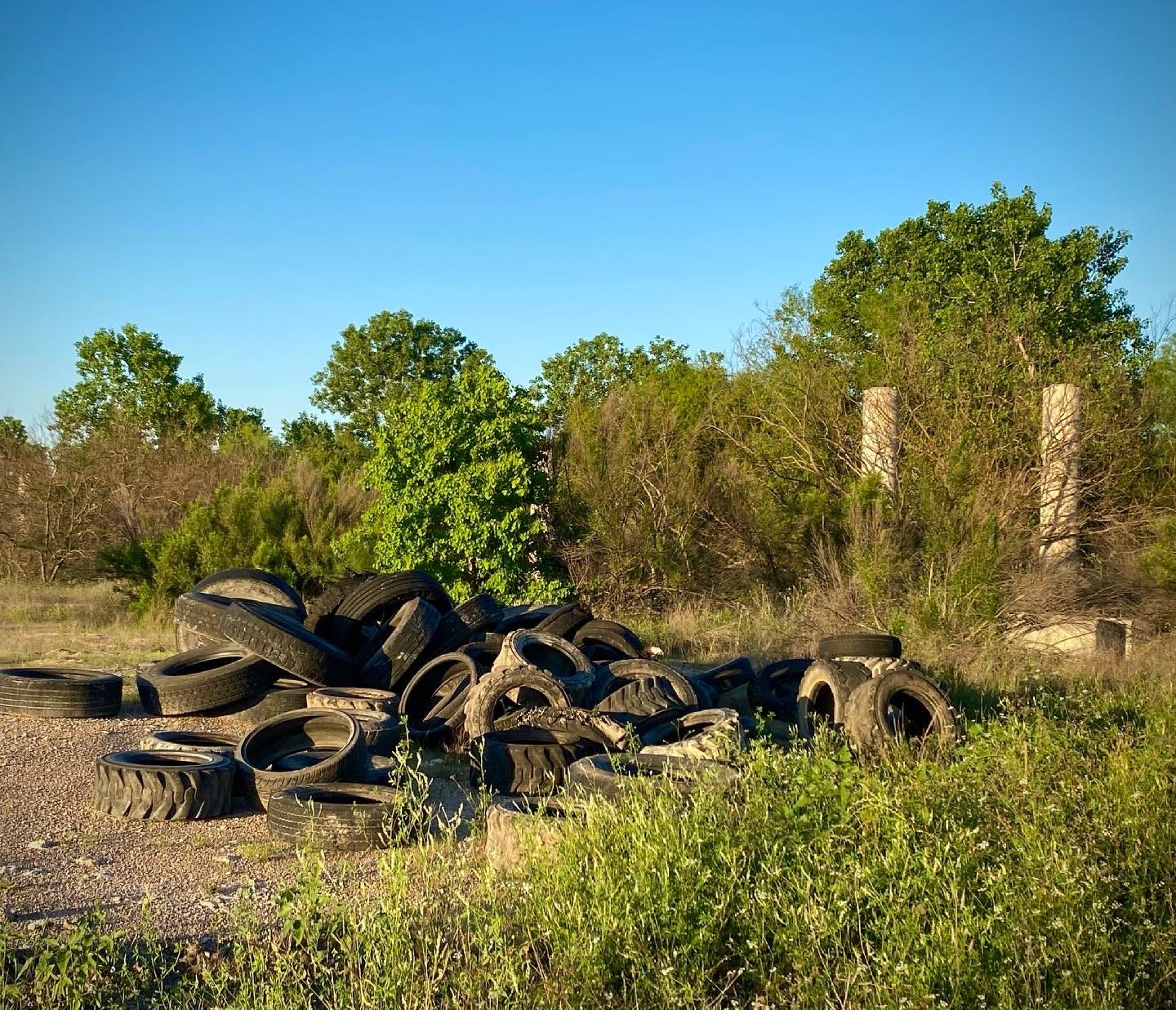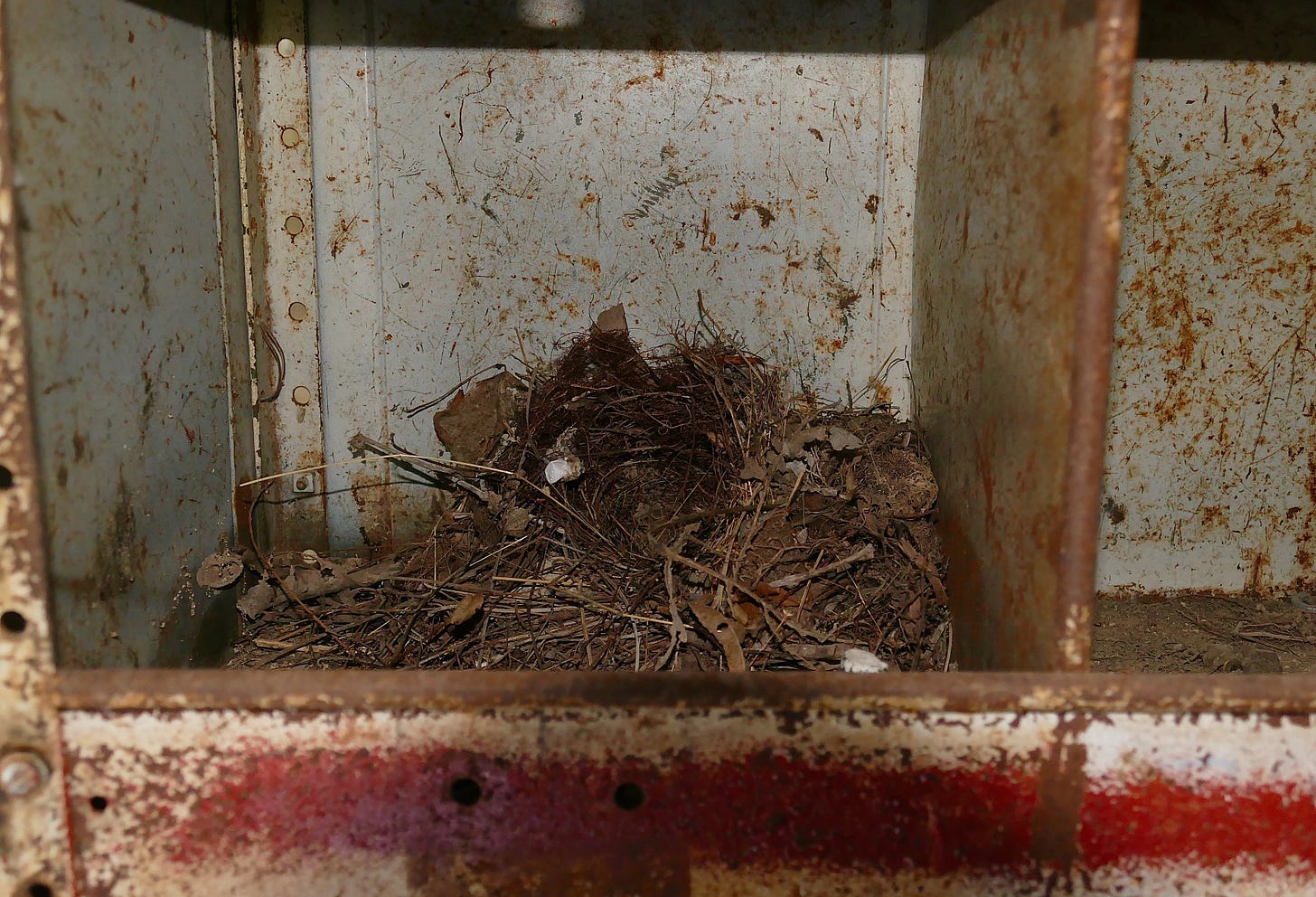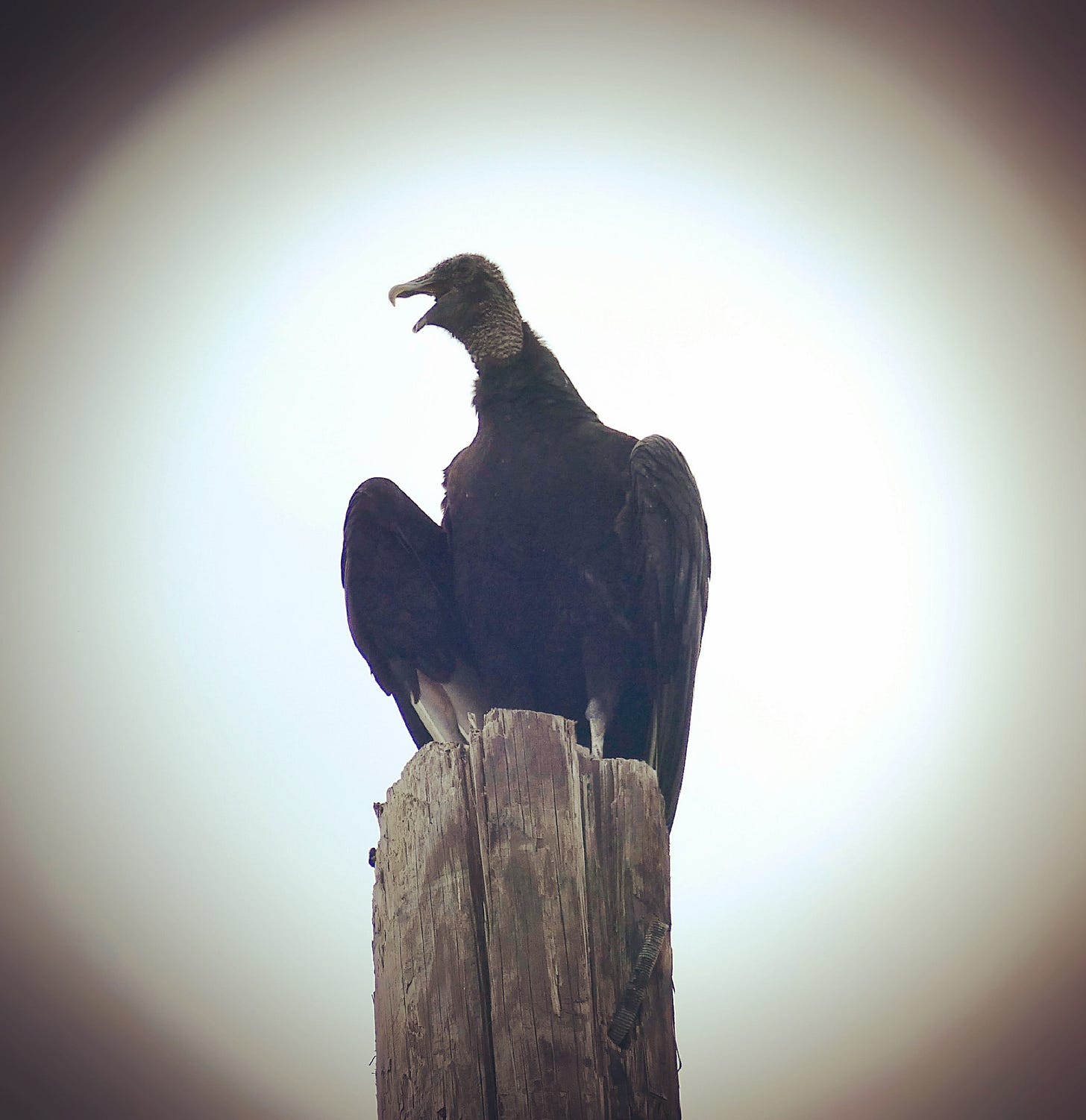Mimosas at the End of the World
Thursday before last I took some shutterbug friends out for a walk in the ruins. It was a date it took us a year to schedule, thanks to the insanity from which we just now seem to be emerging. We met at dusk at the entrance to a manicured little subdivision off the edge of the highway just north of the river, walked along the frontage road a couple hundred yards, and then stepped off into the 67-acre expanse of the abandoned concrete plant that to me would be the most attractive amenity of the new apartment complex about to open next door.
If you found that spot on your phone or computer, and saw the green and the name with which it is marked on the map, you would have reason to believe it is a lovely riverfront park. If you go there, you will find what my friend the science fiction writer Bruce Sterling used to call an “involuntary park”—a site that the former owners trashed to the point where they had exhausted its economic potential and the only viable buyer was Parks & Rec. Since buying the property in 2013, the city has done little planning for the actual park it will ultimately become, and the online reviews of the current park are quite hilarious—lots of one-star gripes about driving all the way across town for this dump. I am trying to enjoy it while it lasts, having heard talk of its flat feral expanse being tamed into tennis courts and soccer fields.
If you visited the place without any of that backstory, you could almost believe you had stumbled across some accidental Chinati, with the big concrete blocks arrayed in mysterious geometries across the marshy plain. The walls that once demarcated the different zones of the operation are crumbling, overgrown with cactus and poison ivy. The amazing ramp to nowhere that was there two years ago is gone, a pile of wild tires dumped at what used to be its landing pad. The one building still standing is a cinder block shack that previously housed an electrical switching station, but urban foragers have harvested all the copper since I first found this place, leaving only the lockers of the workers and a few broken chairs. A songbird made a nest in one of the lockers, but that too has since been abandoned.
The very first time I came to that spot was by water, when it was still an active aggregate plant. My then grade school-age son and I canoed down with a buddy of his who now makes movies, and found a bridge that had been made by the mineral extractors to connect their operations on either side of the river. It was a Saturday, so we pulled up and checked out the site. The bridge is gone now, and you might not notice the footings there beneath the foliage if you didn’t know to look for them. You might even mistake the piles of concrete debris along the banks for regular rocks. Maybe, in a sense, they are.
When my walking companions caught up with me at that spot, you could see the subtle wonder well up in them that such a zone of green tranquility could exist there in the blighted edge of the city. The stillness of the river in the shadows of the tall cypress trees with their gnarled knees, where the channel is deeper and darker because of the dredging. It’s right in the flightpath, but somehow the steady flow of overflying jets and freeway traffic didn’t mitigate the sublime quality of the moment. It enhanced it, really, by letting you see just how resilient the wild ecologies of this continent can be. How thin the layers of our erasure of the wilderness really are. The world we think of as gone forever is right there, just on the other side of the liminal moment where our industry takes a pause.
There on the landing next to a pile of empty Corona bottles someone had dumped a collection of VHS tapes. Action movies, mostly, eclectically curated: Alien Arsenal, Assassins, Blade, Blue Streak, Spartacus. In the middle of the pile, a message from 1999—NO TOMORROW. And you could almost believe it, even as the evidence around you indicated that the rest of the world will still be here after the human civilization that invented the idea of tomorrow runs out of fields to foul.
When we got back to our cars, I led my friends down to the underside of the new overpass to see the swallows. The adaptation of cliff swallows to the habitat afforded by our bridges is one of the things that I first marveled at in this area when I began exploring it twenty years ago, and when we moved here and made our home in the rehabilitated brownfield it was one of the wonders of the season when they would dive back and forth along the edge of our green roof, grabbing the bugs of early summer evenings from the air. But their population had noticeably diminished in recent years, ever since the spring when I witnessed the crews out power-washing their pustular little mud nests from the beams of the old bridges, right before they tore them down to make room for new ones.
Here’s a favorite video of the swallows at the overpass that used to stand right by the involuntary park, shot about a year before its demolition:
They are back in force this year, now that the construction is complete. But as I have seen them out and about over the past couple of weeks, I have noticed some differences. They still nest in the same spots along the high bridges, very much like the bats, but they range farther in time and space, and fly lower. The other afternoon my daughter and I watched them in the empty field outside the abandoned lighting factory, zipping around much closer to us than I had experienced before. They were clustered in that one spot, between the fence and the road, surrounded by light industry. It was another moment like that wormhole by the river, as if that lot was occupying some other temporal trajectory within its four corners.
I began to notice them acting similarly in other spots around here—all of them empty lots that had been left unmowed, presumably flush with small flying insects close to the ground. As I watched them, I noticed that these swallows looked different than the swallows of the seasons before—bluer backs, and more golden breasts. Maybe a different species has moved into the space they left. Or the one that was always here has begun to change, hunting longer hours to seek out the islands of sustenance we leave behind.
The thing I had walked our two-year-old out into the truck-trafficked danger zone to see was not the swallows we got as extra credit, but an astonishing flower I had come upon earlier that day. There at the edge of the driveway of the new motor oil distribution facility was a patch of hot pink legumes that looked like some exotic sugary treat you would eat on a stick. Mimosa strigillosa, I learned when I found it in the book, after thinking it was some lovely weed. Popularly known as powderpuff, a hardy native that does well in sandy soils, growing in sprawling mats across the ground. “Stamens numerous, conspicuously exserted,” said the guide, leaving me to wonder whether “exserted” is a botanical term or a typo.
As remarkable as their beauty was the unlikely site in which they had managed to take root. It couldn’t have been more than twenty feet by ten, between an industrial driveway, a drainage culvert, a major road, and a field dominated by invasive grasses, in a spot that is regularly mowed. They probably have been cut by the time I am writing this. If you walked past them, headed to the nearby bus stop, you likely wouldn’t even notice them.
Sometimes you have to get down to a toddler’s eye view to really appreciate the wonders hiding in plain sight.
Some other roadside attractions
Speaking of Bruce Sterling, the video archive of my May Day conversation with Bruce about his new short story collection Robot Artists & Black Swans is now up courtesy of San Diego’s Mysterious Galaxy bookstore. We had a blast talking about Fantascienza, regionalism, the role of literature in the construction of national identity, writing as an alien, pandemic islands, and becoming a grandparent. Check out the full video here, and/or drop by Mysterious Galaxy’s webstore for copies of Bruce’s and my books.
Bruce used to write an ecology-themed newsletter back in the days before fancy HTML-rich platforms let you pretty up the text with photos and magazine formatting. It was called Viridian, and married science fictional thinking with prescient climate change commentary as notes towards a fresh theory of green design. That’s where I first read Bruce riffing on involuntary parks, giving a name to a kind of place I had always been drawn to. The Viridian newsletter spawned a whole Viridian design movement, and a pioneering group blog called Worldchanging—a blog so cool it became a coffee table book complete with a foreword by Al Gore.
One of the co-founders of the Worldchanging blog and co-authors of the Worldchanging book was Alex Steffen. Steffen this week launched a new project called The Snap Forward, a podcast and weekly newsletter on themes of “climate and ecology, foresight, innovation, cities, finance, ruggedization, predatory delay, bubbles of unsustainability and risk…” It promises to be packed with fresh ideas and insights, and I just subscribed and am looking forward to dialing it in.
My fellow explorers at last week’s involuntary park are the proprietors of a remarkable company called Muyshondt that makes electric torches: the finest and most beautifully-made flashlights I have ever held, which light up the dark woods in a way no other instrument I have carried can manage. Founder Enrique Muyshondt has been making flashlights since he was a kid, and professionalized his skills studying engineering at Texas A&M. His torches combine cutting-edge technological innovation with a neo-Romantic aesthetic that makes them really special. As befits a master of optics, Enrique is also a gifted photographer, which you can find in Muyshondt’s Instagram feed and in the brand’s online magazine The Observatory.
I identified the roadside powderpuff thanks to my favorite guide to local flora: Wildflowers of Texas by Geyata Ajilvsgi, originally published in 1984 and found by me foraging a used bookstore a few years ago. The book is organized by color, with really excellent photos by the author, and exceptionally well-suited to look-ups by botanical novices like me (the author herself, the jacket copy advises, began as an autodidact before becoming a university botanist). It also has one of the grooviest author jacket photos I have seen in a while. And as testament to its quality and utility, the book is still in print almost four decades after its original publication.
And if you’re looking for a movie to watch, here are some recommendations from the ruins:
Observant readers may note that the address of this site has changed, now housed at my own domain. Please let me know if you encounter any technical difficulties accessing the newsletter or archive.
Have a great week, and look before you cross the street, or you might end up like the cat I found this black vulture and ten of its friends fighting over at their Saturday morning wake.















THE SWALLOWS!!! *heart emoji*
Click here for more vultures:
https://www.cbc.ca/radio/asithappens/as-it-happens-tuesday-edition-1.6022063/california-condors-are-very-rare-but-10-of-them-are-trashing-this-woman-s-house-1.6022603